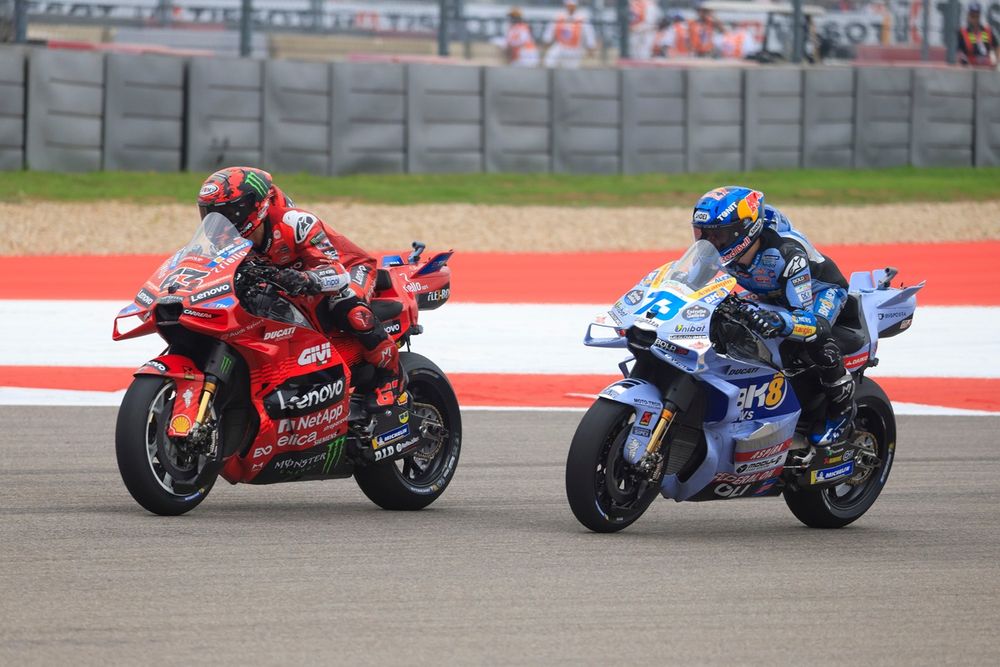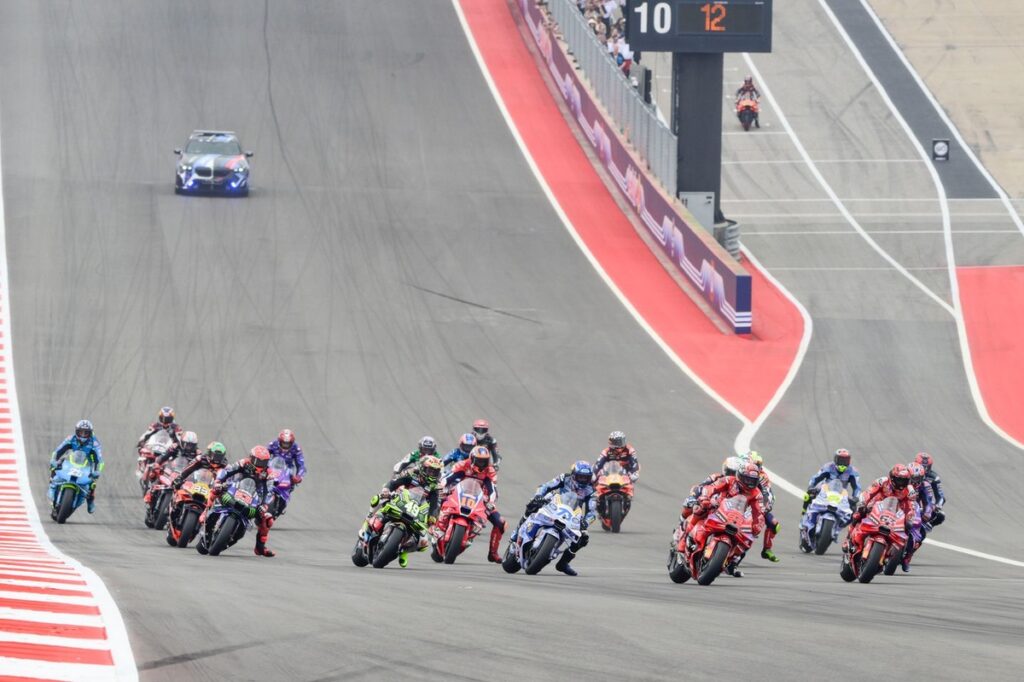When the first attempt at starting Sunday’s MotoGP Americas GP was red-flagged, and then restarted with everybody allowed to change to their ‘dry’ bikes, massive anger broke out in the Trackhouse Aprilia pit. Team principal Davide Brivio was incensed that his rider Ai Ogura – one of three to have already fitted slicks on the grid – would not get the reward for taking that gamble.
You could understand just where Brivio, who expressed his outrage on live television, was coming from. Taking a tyre risk in changeable conditions is, for a team not usually in with a chance of winning, the only opportunity to make the impossible possible. So when, having sat patiently through dry (or fully wet) races for months or even years, that magic mixed-weather day finally dawns, teams like Trackhouse dare to dream.
If such a squad then manages to make what is patently the right call – as Brivio’s crew did on Sunday – trophies start to loom on the horizon and the pulse quickens. The team has grabbed its chance and played exactly the right hand… it’s game on!
So when race control comes along during a red flag and says, ‘By the way, all the big names will be allowed to copy your move at no cost,’ you can grasp why the emotions run high.
We’ve seen the unfairness of such red flag ‘resets’ exposed many times before in motorsport, of course. So often, in fact, that it shouldn’t be necessary to write this piece. These situations should have been banished long ago, but they hang around, smouldering away like a rulemaker’s lucky pair of socks.
The ‘free tyre change’ rule at red flag time has been a topic for years in Formula 1 – and it doesn’t only crop up in weather-related scenarios. Rewind to the accident that stopped a dry Monaco GP in 2011, when Sebastian Vettel got to change his worn tyres for free, thus wiping all previous strategic decisions and ruining a potentially thrilling finish.
In MotoGP and Formula 1, teams can controversially change tyres ‘for free’ during a red flag
Photo by: Gold and Goose / Motorsport Images
These resets don’t just rob ‘minnows’ of opportunity, of course – they can get the big guns moaning too. George Russell felt disadvantaged by it at Mugello in 2020. Lando Norris called it “stupid” and the “worst rule ever invented” in Saudi Arabia, 2021.
Situations in last year’s Monaco and Brazilian GPs also saw calls for the rule to be scrapped. Yet still nothing has been done. It’s like this rule is a sacred cow.
Eruptions over this topic are thankfully less common in MotoGP, if only because race stoppages are less common and the championship – particularly on a dry day – is less strategically complex. Safety cars and compulsory tyre compound switches aren’t a thing, for a start.
Why, when the flaws in this approach have been clearly highlighted so many times, is there this insistence on wiping the strategic slate clean and effectively cancelling the story of the race thus far?
Still, MotoGP is complicit in validating this idea that this rule has a place in top-level motorsport – and it has had its flashpoints before Sunday. On both its visits to Austria in the emergency 2020 schedule, for example, riders were unduly affected by their rivals being allowed to change tyres at stoppages.
These races were in fact dry: the Austrian GP was stopped for the frightening shunt involving Franco Morbidelli, while the subsequent Styrian GP was red-flagged when Maverick Vinales had his dramatic brake failure. And in both, riders who just happened to have more tyres left in their allocation – even though nobody plans for a stoppage in a dry MotoGP race – were effectively rewarded. It was silly, unnecessary and unfair.
A matter of principle
If memory serves, there was a time when the principle of ‘don’t touch your vehicle at a red flag – it’s not a pitstop’ was a fairly fundamental one in motorsport. IndyCar, to its credit, still takes that approach in its regulations. Yet the premier two-wheel and four-wheel categories seem interminably obsessed with the idea of allowing a rubber/vehicle reset whenever red flags are thrown.
Why, when the flaws in this approach have been clearly highlighted so many times, is there this insistence on wiping the strategic slate clean and effectively cancelling the story of the race thus far? It makes no more sense on two wheels than it does on four. In a world of many complex problems that need solving, this isn’t one of them. Red flag equals ‘leave the car alone’. It’s as self-evident as keeping your hands off a crime scene until the police arrive. Why must we keep banging this drum?

The red flag tyre rule remains, despite many case studies which suggest it needs changing
Photo by: David Buono – Icon Sportswire – Getty Images
Sure, the weather or some other factor might change during a red flag. A vicious dog might bite the leader while he’s sitting in the pitlane awaiting the restart. But these are random happenings nobody can legislate for. Unfair stuff happens, but if you follow the principle of nobody being allowed to touch their machines, at least you leave that stuff in fate’s hands. That’s all anybody asks of a motorsport legislator. What nobody asks is that you engineer a situation that was doing just fine developing organically.
A caveat or two
While a ‘don’t touch your bike’ rule should be made a foundational principle for MotoGP red-flag situations as soon as possible, that doesn’t mean a few bits of common sense can’t be applied where necessary.
In the case of a deluge or a track that has become wetter at any point after you’re committed to tyre choice – when the three-minute board is displayed, in MotoGP’s case – it would clearly be nonsensical to insist that MotoGP riders resume on slick tyres. That’s a simple safety issue.
But what you can do is acknowledge that allowing riders to change tyres in this scenario is a special deviation from that fundamental principle. You can acknowledge those who were – by luck or judgement – on the right rubber by requiring those who weren’t to take a ride-through penalty. In the case of MotoGP, that costs comparable time to in-race tyre (bike) swap. It’s a pretty fair substitution.
By contrast, a track going from wet to dry, as COTA did on Sunday, is hardly a safety matter. If you got stuck with wets at the wrong time, you can hobble a lap back to the pits and correct your mistake in normal fashion. There is no case here for interference for officialdom. The guiding principle can remain in place.
There is an argument out there that tyre changes should always be allowed, even in a dry race, because of the possibility that somebody might have run over accident debris. That’s not only an over-the-top bit of Health & Safety; it’s the kind of official over-engineering we’ve explored already. It targets a kind of fairness that ignores racing reality and only exists on paper.
It is likely Bagnaia would not have won the Americas GP had he not been able to switch tyres during the red flag
Photo by: Ducati Corse
As long as you have a warm-up or sighting lap before the restart, riders will have an opportunity to feel whether anything has gone wrong before they go racing. And if it has? Then they’re free to pit and rejoin the race when it has been addressed! Yes, absolutely, this is an unlucky scenario for a rider who may have innocently picked up a piece of someone else’s crash. But again, at least that’s bad luck that’s down to fate. It’s preferable – I think – to officialdom shifting the bad luck onto those who were winning the strategy fight, in a misguided, never-gonna-work attempt to create fairness.
In any case, the debris argument is clearly rooted in car racing, where contact is common and bodywork tends to scatter more liberally, more often. Debris is only rarely an issue in motorcycle racing.
Returning to principles and deviations: no, you cannot rule out occasions where mechanical or tyre interventions during stoppages are just common sense. But you can also have legislation that covers these scenarios fairly. IndyCar, for example, can ‘approve’ work on your car during red flags, but you’re going to the back of the restart snake if that work is done. (Rule 7.1.4.2d, if you’re interested!)
Referring to the constitution…
The current FIM Grand Prix World Championship Regulations document runs to 381 pages. As the confusion around the grid procedure at COTA showed, there are still some grey areas in there. And while there’s no problem with addressing these, a few rock-solid guiding principles might help everybody understand how to handle new situations a little better.
To drill down on the principle in question: there’s an underlying, intuitive morality to red-flag situations that all motorsport people understand. Even those who profited from the mess at COTA – including winner Francesco Bagnaia and runner-up Alex Marquez – acknowledged that the situation had been unfair on riders like Ogura and team bosses like Brivio. Everyone understands that no stoppage – particularly one you’ve caused! – should be an opportunity to undo mistakes made before that.
If that principle is so clear to all concerned, it’s probably worth adding a 382nd page and getting it down on paper as a kind of constitutional guideline. It appears F1’s lawmakers need to be arm wrestled to take a step like that – can MotoGP show itself to be a little less set in its ways?
Will the rules surrounding a red flag ever change in MotoGP?
Photo by: Gold and Goose / Motorsport Images
In this article
Richard Asher
Formula 1
MotoGP
Be the first to know and subscribe for real-time news email updates on these topics
Subscribe to news alerts
Read the full article here

